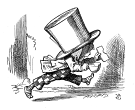Search us!
Search The Word Detective and our family of websites:
This is the easiest way to find a column on a particular word or phrase.
To search for a specific phrase, put it between quotation marks. (note: JavaScript must be turned on in your browser to view results.)
Ask a Question! Puzzled by Posh?
Confounded by Cattycorner?
Baffled by Balderdash?
Flummoxed by Flabbergast?
Perplexed by Pandemonium?
Nonplussed by... Nonplussed?
Annoyed by Alliteration?

Don't be shy!
Send in your question!
Columns from 1995 to 2006 are slowly being added to the above archives. For the moment, they can best be found by using the Search box at the top of this column.
 If you would like to be notified when each monthly update is posted here, sign up for our free email notification list.
If you would like to be notified when each monthly update is posted here, sign up for our free email notification list.
Trivia
All contents herein (except the illustrations, which are in the public domain) are Copyright © 1995-2020 Evan Morris & Kathy Wollard. Reproduction without written permission is prohibited, with the exception that teachers in public schools may duplicate and distribute the material here for classroom use.
Any typos found are yours to keep.
And remember, kids,
Semper Ubi Sub Ubi
|
Long-lost for a reason.
Dear Word Detective: What is the definition of “couzened,” as in “was now resolved to be couzened no more”? Thanks for the help! — Rebecca.
Thanks for a good question. I remember running across that word many times over the years, and inferring its meaning from its context, but I’d never, until now, taken the time to investigate its background.
You don’t give a source for the quotation you cite (assuming it is a quotation from something you’ve read), but a Google search turns up only one source online for those exact words, “William Lilly’s History of His Life and Times From the Year 1602 to 1681,” which was published in London in 1715. Lilly was an interesting fellow, a famous English astrologer who specialized in predicting events with what is said to have been notable success. He predicted, most famously, the Great Fire of London fourteen years before it happened, for which he was rewarded by being investigated on suspicion of having started it himself. He was acquitted.
The particular passage in which Lilly uses “couzened” is titled “Of My Marriage the First Time,” and begins with a description of his beloved: “My mistress, who had been twice married to old men, was now resolved to be couzened no more; she was of a brown ruddy complexion, corpulent, of but mean stature, plain, no education, yet a very provident person, and of good condition….” Twice bitten and now once shy, Lilly’s paramour evidently had a low opinion of her former husbands, apparently with good reason.
To “cozen” (which is the standard spelling of the word today) is “to cheat, to deceive or to defraud by duping.” The word first appeared in English in the late 16th century, probably as slang of the criminal underworld.
There are two proposed origins of “cozen,” and this is one of those rare cases where both may be true. The more straightforward theory traces the word to the old Italian verb “cozzonare,” meaning “to play the horse trader” and, horse trading being a notoriously shifty business, “to play the crafty thief.”
A more colorful theory, however, traces “cozen” to the word “cousin” and specifically the Old French verb “cousiner,” meaning “to claim kinship in order to cheat.” Evidently it was not uncommon for knaves to go literally door to door, claiming to be the long-lost cousin of the residents, in order to gain their trust (and money). This theory is bolstered by the use of the English phrase “to make a cousin of” meaning “to cheat” in the 16th century.
As I said, both stories may be true. Perhaps the word did originally derive from the Italian “cozzonare,” but its resemblance to the English “cousin,” and the well-known use of fraudulent kinship to dupe victims by thieves, popularized “cozen.” Whatever the story, “cozen” is a very cool word.
Might as well throw in the trowel.
Dear Word Detective: I have been having an ongoing argument with a dear friend about the phrase “for all intents and purposes,” which she swears to the death is “for all intensive purposes,” and says I sound like a ninny when I say it wrong. Can you figure out how this phrase crept into common usage and help us settle this dispute? — Collectively Confused in Columbus.
I guess this column isn’t as effective a deterrent to silliness as I had hoped, because I actually answered a question about “to all intensive purposes” about ten years ago, and yet here we are again. You are, of course, correct, and not at all a ninny, at least on this question. The phrase is indeed “for all intents and purposes,” meaning “for all practical purposes” or “in any reasonably likely circumstance” (“After Bob punched his boss, his career at the firm was, for all intents and purposes, kaput”). “For all intents and purposes” has been around since at least 1546 (in the form “to all intents, constructions, and purposes” contained in a law decreed that year by Henry VIII).
The mangled form “for all intensive purposes” has been “spotted in the wild” in print (and noted by linguists) at least since the 1980s, although, as an error in speech, it may have been around much longer. “For all intensive purposes” is a classic “eggcorn,” a re-shaping of a word or phrase that, far from being a simple error, has flourished and persisted because it actually makes a certain amount of sense. The term “eggcorn” itself was coined in 2003 by linguist Geoffrey Pullum when someone online was noticed typing “eggcorn” instead of “acorn.” It was, of course, an error, but an acorn is indeed rather egg-shaped, and is a seed, as is corn, so if one has heard “acorn,” but never seen the word in print, writing it as “eggcorn” is not entirely crazy.
Similarly, “for all intensive purposes” might be defended as logical if “intensive” were interpreted to mean “serious, realistic, or practical,” making the phrase equivalent to “when push comes to shove” (“Smith is a decent hitter, but for all intensive purposes, he’ll be useless in the playoffs”). It’s still “wrong” in that it mangles a long-established English idiom, but it’s not as far off the beam as “The ants are my friends, they’re blowin’ in the wind” or “There’s a bathroom on the right.”
As to how “intensive purposes” crept into common usage, I think it’s significant that the 1980s also saw the proliferation of “intensive care units” in hospitals and the ensuing use of “intensive” to sell everything from skin lotion to motor oil. Given that “intents and purposes” has a distinctly archaic ring to it, and that “intents” is more rarely used than “aims” or “goals” today, and “intensive” seems like a logical interpretation to folks who have only heard (and never read) the proper form of the phrase.
Mmmph?
Dear Word Detective: Shortly after the birth of my nephew, my sister-in-law informed the family that she did not want his pacifier to be referred to as a “binky.” That got me wondering where the term came from in the first place and then how it became a common term for a baby’s pacifier. — J. Smith.
Hmmph. Kids are hopelessly spoiled these days. When I was an infant, we didn’t have any fancy-schmanzy “pacifiers.” If we wanted something to gnaw on, we got off our duffs and found a nice twig, and we turned out just fine. Besides, last time I checked, the human hand comes with a dandy built-in pacifier. I still use mine at tax time.
I am intrigued as to why your sis-in-law doesn’t want people calling her sprog’s pacifier a “binky.” If it’s because she finds the term insufferably cutesy and cloying, I’m with her all the way.
The pacifier in its modern form of a plastic or rubber nipple attached to a ring or shield (to prevent the child from swallowing the gizmo) dates to the early 20th century, but the use of similar devices to calm an upset infant is probably as old as upset infants themselves. Evidently in the 19th century it was common practice to give the child a ball of linen cloth wrapped around a lump of sugar or, a bit disturbingly, meat or fat, sometimes soaked in brandy. According to Wikipedia, teething toys in 17th century England were often made of coral. Yum.
I was surprised to learn that “Binky” is actually a trademarked term owned by Playtex, which registered it in 1935. But as a generic term for the device, “binky” is substantially older, and the word “binky” itself has a history apart from pacifiers. The Dictionary of American Regional English (DARE) lists “binky” as a folk term used in western Indiana as of 1912 to mean “any little mechanical contrivance,” and the word seems to have been in use for many years as a name for anything small and either inconsequential or cute. “Binky” is, for instance, popular as both a name for small dogs and a jocular nickname for men.
So, does “binky” actually mean anything? My guess is no. There is a Scots dialect word “bink” meaning “bench” or “shelf,” but I can’t imagine a connection to the way “binky” is used today. My guess is that “binky” is an onomatopoeic formation, a word whose sound conjures up a mental image, in this case of something small, not terribly important, but fun to have around.
|
Makes a great gift! Click cover for more.  
400+ pages of science questions answered and explained for kids -- and adults!
FROM ALTOIDS TO ZIMA, by Evan Morris
 
|


 can be found
can be found 




Recent Comments